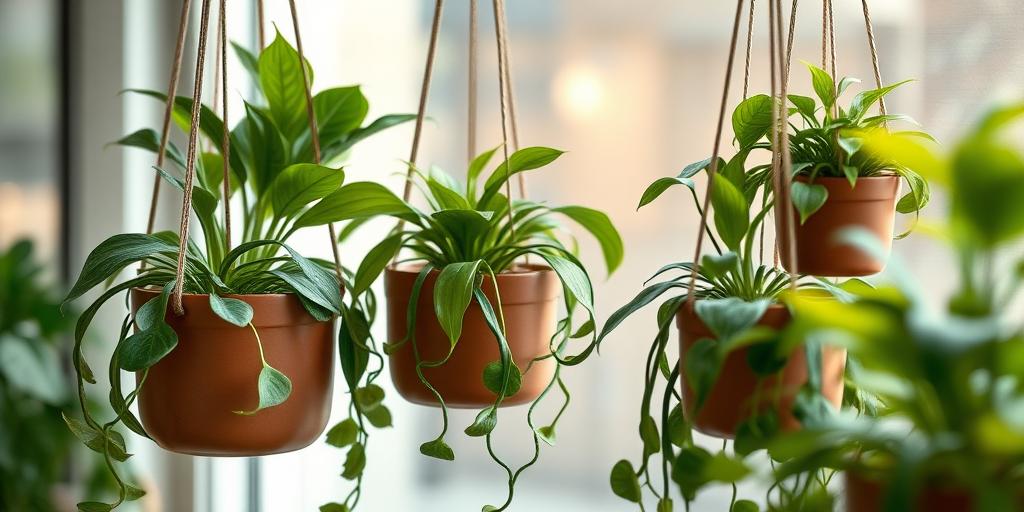
Best Low Light Hanging Plants (No Sunlight Required!)
Discover the best low-light hanging plants that thrive without sunlight! Perfect for dark corners, offices, or apartments, these easy-care plants add greenery to any space.
Introduction
Did you know some plants can flourish even in the dimmest corners of your home? If you love greenery but lack bright windows, don’t worry—nature has a solution! Low-light hanging plants are the perfect way to bring life to dark spaces, whether it’s a shady bathroom, a dim office, or a north-facing room. In this guide, we’ll explore the best trailing and cascading plants that thrive without direct sunlight, along with care tips to keep them lush and healthy. Let’s dive in!
Why Choose Low Light Hanging Plants?
Low light hanging plants are a game-changer for anyone who loves greenery but doesn’t have access to bright, sunny spaces. Whether you live in an apartment with small windows, work in an office with fluorescent lighting, or just have a dimly lit bathroom, these plants can thrive where others would struggle.
One of the biggest perks? They’re incredibly low-maintenance. Many low light hanging plants can tolerate irregular watering and don’t demand constant attention, making them perfect for busy plant parents. Plus, they don’t just survive—they enhance your space by improving air quality and adding a touch of natural beauty.
Top Low Light Hanging Plants That Don’t Need Sunlight
If you’re ready to bring some greenery into your low-light space, here are six of the best hanging plants that thrive without direct sunlight.
1. Pothos (Epipremnum aureum)
Pothos is practically the poster child for low light hanging plants. It’s tough, adaptable, and can survive in almost any lighting condition—even fluorescent office lights. Its long, trailing vines make it perfect for hanging baskets or draping over shelves.
One of the best things about pothos? It forgives neglect. If you forget to water it for a while, it won’t hold a grudge. Just let the soil dry out slightly between waterings, and it’ll keep growing happily.
2. Spider Plant (Chlorophytum comosum)
Spider plants are another fantastic choice for low light spaces. They thrive in indirect light and produce adorable little “spiderettes” that dangle from the mother plant—you can even snip these off and propagate new plants.
Beyond their charming appearance, spider plants are known for their air-purifying abilities. They help remove toxins like formaldehyde and xylene from the air, making them a great pick for bedrooms or offices.
3. Philodendron Heartleaf (Philodendron hederaceum)
With its fast-growing vines and heart-shaped leaves, the philodendron heartleaf is a favorite among plant lovers. It adapts well to low light and is super beginner-friendly—perfect if you’re new to houseplants.
This plant loves to trail, so it looks stunning in a hanging planter or cascading from a high shelf. Just keep it away from direct sunlight, which can scorch its delicate leaves.
4. English Ivy (Hedera helix)
English ivy brings a touch of classic elegance with its trailing vines and lush foliage. It prefers cooler, shaded spots, making it ideal for dim corners or north-facing rooms.
You can grow English ivy in soil or even in water—just place a cutting in a vase, and it’ll develop roots over time. Keep an eye out for pests like spider mites, though, as ivy can be prone to infestations if not checked regularly.
5. ZZ Plant (Zamioculcas zamiifolia)
If you want a plant that’s nearly indestructible, the ZZ plant is your best bet. It thrives in low light and can go weeks without water, thanks to its thick, tuber-like roots that store moisture.
Its glossy, dark green leaves add a sleek, modern touch to any space. Just be careful not to overwater it—ZZ plants prefer to stay on the dry side.
6. String of Hearts (Ceropegia woodii)
This delicate beauty features tiny, heart-shaped leaves on long, trailing stems. While it prefers bright indirect light, it can tolerate lower light conditions, though its growth may slow down.
String of Hearts is drought-tolerant, so it’s perfect if you tend to forget watering. Just make sure it has well-draining soil to prevent root rot.
How to Care for Low Light Hanging Plants
Even though these plants are low-maintenance, they still need some basic care to stay healthy and vibrant. Here’s what you need to know:
Watering
Overwatering is the quickest way to kill a low light plant. Since these plants aren’t getting strong sunlight, they don’t dry out as quickly. Always check the soil before watering—stick your finger in about an inch deep. If it feels dry, it’s time to water. If it’s still damp, wait a few more days.
Soil
A well-draining potting mix is key. Look for a blend that includes perlite or orchid bark to prevent water from pooling around the roots. For plants like pothos or philodendrons, a standard indoor plant mix works well.
Fertilizing
Low light plants grow slower than sun-loving ones, so they don’t need heavy feeding. A diluted, balanced liquid fertilizer once a month during spring and summer is plenty. Skip fertilizing in fall and winter when growth naturally slows.
Pruning
If your plant starts looking leggy (with long, sparse stems), don’t hesitate to trim it back. Pruning encourages bushier growth and keeps the plant looking full. You can even propagate the cuttings to grow new plants!
Pests
Watch out for common pests like spider mites and mealybugs, especially in dry indoor environments. Wiping the leaves with a damp cloth or spraying them with neem oil can help keep pests at bay.
Best Places to Hang Low Light Plants
Now that you’ve picked your plants, where should you put them? Here are some of the best spots for low light hanging plants:
Bathrooms
Many low light plants, like pothos and philodendrons, love humidity. Hanging them in a bathroom (especially near a shower) gives them the moisture they crave while adding a spa-like vibe to the space.
Office Desks and Bookshelves
Brighten up a dull workspace with a trailing pothos or spider plant. These plants thrive under artificial lighting and can help purify the air in stuffy offices.
Dark Corners and Hallways
Got a dim corner that needs life? A ZZ plant or English ivy can thrive there. Their lush foliage adds warmth to otherwise forgotten spaces.
Kitchens with Minimal Sunlight
If your kitchen doesn’t get much natural light, try hanging a string of hearts or philodendron near a window (even if it’s not super bright). They’ll add a touch of green without needing direct sunlight.
With the right care and placement, low light hanging plants can transform even the darkest spaces into lush, inviting retreats. Happy planting!
Conclusion
Who says you need bright sunlight to enjoy lush greenery? With these low-light hanging plants, you can transform even the darkest spaces into thriving indoor jungles. Whether you choose the resilient pothos, the elegant English ivy, or the charming string of hearts, these plants are sure to bring life to your home with minimal effort. Ready to get started? Pick your favorite and let nature work its magic!
